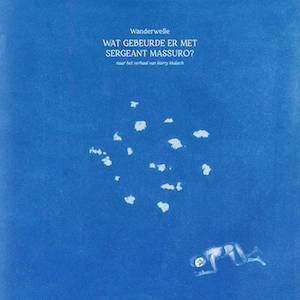
Taking a break from completing their trilogy of albums examining the impact of global warming on the world’s coastal regions, Amsterdam’s Wanderwelle have instead created a new work that considers the damaging consequences of authoritarian rule and dogmatic self-interest.
Their source material is a short story, “What Happened to Sergeant Massuro?”, published in 1957 by the Dutch author, Harry Mulisch. Told by one Lieutenant Loonstijn, the tale recounts the uncanny transformation of Massuro – sent on missions throughout the former Dutch East Indies to subjugate and suppress the inhabitants there – from a dutiful military cog to a lifeless statue of stone. As Loonstijn relates Massuro’s story to a faceless tribunal, he wrestles with the fact that no medical rationale has been offered to explain Massuro’s transformation – beyond the possibility of overwhelming remorse for abuses perpetrated in the line of duty producing a kind of fatal mineral discharge from his psyche. This diagnosis implicates Loonstijn himself for his own role in a campaign of ruthless colonization, while suggesting a larger legacy of oppressors’ hearts and minds turned to stone throughout human history.
While being familiar with the details of Mulisch’s story certainly adds to one’s appreciation of Wanderwelle’s music, what they’ve created on Wat gebeurde er met Sergeant Massuro? is more than enough to pull in the listener. From its dire, slowly approaching thunderstorm opening with its glinting piano strikes of rain, they conjure up a relentlessly dank, murky, multi-textured atmosphere through both electronic and acoustic means that extends across the album and reflects a visceral and psychological plunge into a bottomless heart of darkness.
Cavernous spaces throb with drifting pads, whirring drones, and the resonating tones of cloud-chamber bowls and gongs on “Schaduwruis (Shadow Noise).” Venturing deeper, the listener encounters buzzing, chittering insects and electronic birdcalls carving out space against a menacing, humming thicket on “Ondergrondse verbindingen (Underground Connections),” yet the vaguely familiar offers nothing in the way of comfort. “Herrinneringen/Bekentenis (Memories/Confessions”) is all stark, tormented atmosphere filled with pockets of silence torn open by terrified, muffled voices and bursts of clattering percussion. “Verdwijnend vlees (Vanishing Flesh)” pulses with time and sound running backwards, sucking themselves into airless silence before the void fills with the gritty textures of raw stone being dragged. And the album ends with the mournful, melodic church organ of “Een nieuw soort mens (A New Kind of Person),” undercut with what sounds like terse feed from a police scanner.
Wanderwelle’s trilogy-in-progress features antique calvary trumpets and an irreparably damaged church organ as if to alert us to the damage we’re doing to our planet. While it’s not immediately apparent, on WHTSM it appears that Wanderwelle is continuing that call, examining this time around the ways in which pernicious choices and thoughtless actions of the past have an impact on the present and the future. WHTSM is a heavy dose of accusation and calling to accounts, but there’s no time like the present to listen. (Damian Van Denburgh)
